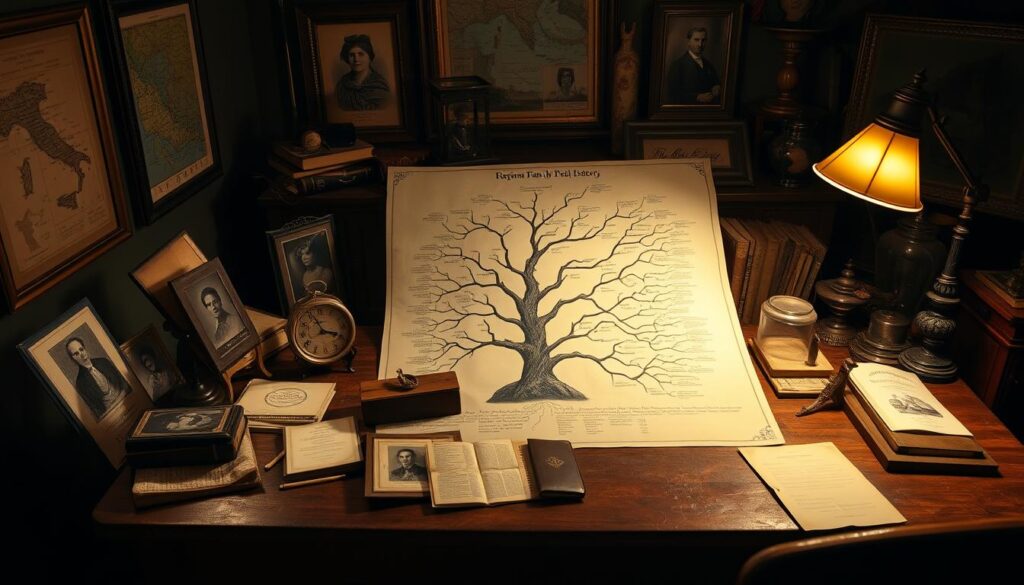Picture strolling through cobblestone streets where your great-grandparents once walked. Feel the Italian sun warming your face. Embrace long-lost relatives who share your ancestral roots. This journey awaits 60 to 80 million people with Italian heritage worldwide.
Tracing your Italian family history uncovers a rich tapestry of stories and traditions. Italy has named 2024 the “Year of Italian Roots in the World”. It’s the perfect time to explore your genealogy and connect with Italian relatives.
Anthony visited seven ancestral villages of his great-grandparents in Italy. Lou Del Bianco spent 45 years seeking recognition for his grandfather, Luigi. Luigi was the chief carver of Mount Rushmore.
Italian genealogy research offers many resources. Online ancestry websites, cultural organizations, and emigration experts can help uncover your family’s story. Build your family tree on Ancestry or MyHeritage before your trip. This can help you connect with relatives and plan your itinerary.
Prepare for a successful and fulfilling experience. Learn enough Italian to communicate effectively, especially for official requests. Know the operating hours of local Comune records offices. Use translated written information when meeting with officials.
Exploring Italian family ties can lead to deep connections and discoveries. Early 2023 estimates show an 11% increase in roots tourism over 2019. You’ll join a growing movement of Italian descendants reconnecting with their heritage.
Start your journey now, whether you’re researching your genealogy or seeking your family’s Italian village. With an open heart and adventurous spirit, you’ll create lasting bonds and unforgettable memories.
Understanding Your Italian Heritage
Exploring Italian roots connects you to ancestors and their rich culture. From 1800s to 1900s, 5.5 million Italians left home seeking better lives. At-home DNA testing boosted interest in Italian heritage exploration.
FamilySearch is a top resource for Italian genealogy research. It offers 150 million images of records with 500 million names globally. The Italians to America Passenger Data File indexes 800,000 passengers from Italy.
Italian church records since the 1500s provide valuable genealogical information. Birth and death records offer insights into family history. Town Vital Records Offices hold most useful genealogical records in Italy.
Comuni-Italiani helps identify relevant Town Archives. It provides details on Italy’s regions, provinces, and municipalities.
“Tracing your Italian heritage is not just about uncovering names and dates; it’s about understanding the stories, traditions, and values that have shaped your family through generations.”
Not all Italian genealogical records are searchable by name. Knowing your family’s ancestral town is often necessary for thorough searches. Some State Archives’ records in Italy still need digitization and indexing.
Getting Started with Family Research
Locating Italian relatives online can be exciting and rewarding. Start by building your family tree on Ancestry or MyHeritage. These platforms offer resources, search tools, and messaging features to connect with relatives.
Take an at-home DNA test to jumpstart your search. Mail back your sample to uncover genetic links and ancestral origins. DNA testing has become popular, with millions participating worldwide.
Many countries, including Italy, offer services to help complete your family tree. These can be useful when online resources are exhausted. Vital records can be found in county archives.
State archives hold valuable genealogical records. These include state censuses, military records, and court documents. They can provide insights into your family’s past.
“Family is not an important thing. It’s everything.” – Michael J. Fox
Explore the National Archives and Records Administration (NARA) for genealogical research. They maintain military service records and passenger arrival documents. County courthouses and churches also hold valuable family history information.
Use these diverse resources to connect with Italian relatives. You’ll uncover the rich tapestry of your family history. Happy researching!
Utilizing Online Genealogy Tools
Italian genealogy research has become more accessible with online resources. Ancestry, MyHeritage, and FamilySearch offer tools for building family trees and finding relatives. These platforms provide access to millions of Italian records from 1806 to today.
These records include birth, marriage, and death certificates. They span from the Napoleonic Civil Registration to modern times. Users can explore centuries of family history through these digital archives.
Antenati is a top website for Italian research. It organizes records by province, period, town, type, and year. This structure makes it easy to navigate the vast collection.
Not all records are digitized yet. However, Antenati continues to expand its offerings. This growth provides hope for future discoveries in family history research.
“The key to successful Italian genealogy research is patience and persistence. With the right tools and resources, you can uncover your family’s rich history and connect with relatives you never knew existed.” – Maria Rossi, Genealogist
DNA testing is powerful for finding Italian relatives online. Services like Ancestry and MyHeritage link you to potential relatives. They also break down your genetic makeup by country, revealing insights into your heritage.
Online records are a great start. But don’t stop there. Reach out to professional genealogists for more help. Local cultural organizations can also assist in connecting with your Italian roots.
Reaching Out to Family Members
Connecting with Italian relatives can be rewarding when uncovering your family history. After gathering reliable ancestor information, it’s time to reach out to potential family members. Many Italian Americans want to learn more about their ancestry.
Traditional Italian naming conventions can help identify relatives. Families often followed specific patterns when naming children. Understanding these conventions can make identifying potential relatives in your family tree easier.
When contacting potential relatives, be respectful and patient. Many people discover new family facts by talking to older relatives. Collecting official documents can help find ancestral village information.
“I never imagined I would find so many relatives in Italy. It’s been an incredible journey of discovery and connection.” – Maria, Italian American genealogy enthusiast
Researching ancestral villages can deepen your connection to Italian heritage. Many feel a stronger link to their ancestry after studying their family’s village. Visiting these villages often creates a significant emotional bond.
Use various methods to contact potential relatives, like letters, emails, or social media. Many have success connecting through letters. Taking initiative may lead to face-to-face meetings and lasting relationships.
Italian Family Structure and Dynamics
Italian family tree research requires understanding unique family dynamics. Italian culture values strong family bonds. Cherished gatherings and celebrations are central to social interactions. Extended families often live close by.
Italian families were traditionally larger. Recent decades have seen smaller households due to declining fertility rates. Family ties remain crucial. Weekly family dinners, usually on Sundays, are common.
Italian language has specific family relationship terms. Regional variations exist for words like “dad”. “Nipote” can mean four different English family members. These linguistic nuances reflect complex Italian family structures.
“Family is not an important thing. It’s everything.” – Michael J. Fox
Modern Italian families are evolving due to changing social norms. Western influences are shaping contemporary family dynamics. Traditional gender roles persist among older generations. Younger urban Italians embrace more egalitarian household responsibilities.
Understanding Italian family structures enhances family tree research. It provides insights into heritage and ancestral relationships. This knowledge enriches the exploration of Italian family histories.
Exploring Regional Differences in Italy
Italian family history research requires understanding regional differences in Italy’s diverse cultural landscape. Each region offers a unique blend of history, cuisine, and traditions. These factors have shaped the lives of our ancestors across Italy.
Northern Italy is famous for its bustling cities like Milan, a global fashion hub. The region’s cuisine features rich, buttery dishes like risotto and polenta. These are often paired with robust wines such as Barolo and Amarone.

Central Italy showcases the Renaissance splendor of Florence and Tuscany’s rolling hills. Picturesque vineyards and medieval towns dot the landscape. The warm Mediterranean climate embraces southern regions like Campania and Sicily.
Naples, pizza’s birthplace, pulses with vibrant energy. Sicily’s ancient ruins and cuisine reflect its complex history. Sardinia, an island off the mainland, boasts its own unique traditions.
“Italy’s regional differences are not just about geography; they are about the people, their traditions, and their way of life.”
Regional dialects and customs remain strong, shaping Italian identities. Understanding these nuances provides valuable insight into ancestors’ lives. This knowledge helps piece together a more complete picture of your family history.
The Role of Social Media in Connecting
Social media platforms like Facebook have become powerful tools for connecting with Italian relatives. They help discover family heritage and engage with distant relatives who share common ancestry. Italian American genealogy groups on Facebook make it easier to connect with family.
Facebook offers a unique platform for closer connections among those interested in Italian immigrant history. Members collaborate to fill in gaps in their family trees. They share advice and provide insights into their shared heritage.
Posting about specific family names and towns can lead to surprising discoveries. New family connections can be made, even across continents. One user received help translating an Italian dialect document within minutes of posting.
Another user found a potential 4th-6th cousin based on DNA results. This shows Facebook’s potential for locating Italian relatives online. Social media can bring families together across great distances.
“I never imagined I would find a long-lost cousin through a simple Facebook post. It’s amazing how social media can bring families together across great distances.”
Joining Italian genealogy groups on Facebook often requires approval from a group administrator. This ensures a secure environment for sharing sensitive family information. These groups cover various aspects of Italian ancestral research.
You can expand your network of Italian relatives using social media. Uncover new branches of your family tree and deepen your connection to Italian heritage. Explore the vibrant community of Italian genealogy groups on Facebook today.
Participating in Family Reunions
Family reunions in Italy offer a rewarding way to connect with Italian relatives. You can strengthen bonds and create lasting memories. Visiting ancestral homes and paying respects at family cemeteries can be deeply moving experiences.
Italy is perfect for multigenerational trips and special celebrations. Abruzzo, just a few hours from Rome, is ideal for authentic Italian experiences. This region boasts three National Parks and is Europe’s greenest area.
Imagine touring Old Rome’s historical sites like the Colosseum and Trevi Fountain. Then, hike in Majella National Park or go wine-tasting with local cheeses. You could even raft along the Aventino River for an adventure.
Try your hand at making ricotta cheese and homemade pasta at an Abruzzo farmhouse. These activities let you engage with local traditions and culture.
“Connecting with our Italian relatives during a family reunion was a once-in-a-lifetime experience. Watching our children, Stella and Marcel, bond with their cousins in the same olive orchard our ancestors tended for over 400 years was truly magical.” – Rob and Alexis, family travelers
Organizations in Italy can arrange personalized reunions and roots travel experiences. They offer guided tours, cultural activities, and traditional farewell dinners. These customizable itineraries ensure an unforgettable journey of discovery and connection.
Preserving Family History
Italian genealogy research can uncover fascinating stories about your family’s past. Old photos, records, and heirlooms help piece together your family’s rich narrative. These treasures deserve preservation for future generations.

Interviewing older relatives captures precious memories that might otherwise be lost. This practice also strengthens family bonds across generations. In 2015, research showed 56% of Americans wanted to learn more about their family history.
“Over 25 million Americans have Italian ancestry according to estimates from the U.S. Census Bureau, with approximately 1 in 6 Americans claiming Italian heritage.”
Your ancestors might have been part of the mass Italian migration between 1861 and 1924. Over 25 million Italians immigrated to countries worldwide during this period. Today, about 85 million Italian descendants live outside Italy.
These descendants reside in countries like Brazil, Canada, Venezuela, and Argentina. The United States, France, and Australia also have significant Italian populations. Your research contributes to the stories connecting generations across time and space.
Building your Italian family tree is a journey of discovery. Cherish the memories you uncover along the way. Your efforts preserve a unique piece of history for future generations.
Celebrating Italian Heritage
Connecting with Italian relatives celebrates your heritage. Tracing your family history uncovers rich traditions and customs. This strengthens your identity and allows sharing Italian culture with loved ones.
Italian Americans have shaped U.S. politics, arts, sports, and science. Frank Sinatra and Lady Gaga made their mark in music. Martin Scorsese and Francis Ford Coppola created thought-provoking films.
In sports, Joe DiMaggio and Yogi Berra became symbols of excellence. They represent cultural pride for Italian Americans.
Italian cuisine is a beloved part of the heritage. Spaghetti, lasagna, and pizza are now American staples. These meals bring people together, creating warmth and togetherness.
“Italian American scientists such as Enrico Fermi and Robert Gentile have made groundbreaking contributions in nuclear energy and aerospace engineering, respectively.”
October is Italian American Heritage Month. Cities celebrate with events, parades, and festivals. New York, Chicago, and San Francisco showcase Italy’s sights, sounds, and flavors.
Museums highlight Italian American history and culture. They showcase the struggles and triumphs of immigrants and their descendants. The Italian American Museum in New York City is one example.
Exploring your Italian roots may lead to dual citizenship. This process reconnects you with your heritage deeply. It offers benefits like education and employment in Italy and the EU.
Embracing your Italian heritage is a journey of self-discovery. It builds pride and connects you to a rich cultural tapestry. This journey spans generations and enriches your life.
Navigating Language Barriers
Language barriers can be challenging when connecting with Italian relatives. English is widely spoken, but many Italians prefer their native language. Italian dialects vary by region, including Sicilian, Neapolitan, and Venetian.
Translation apps and learning key phrases can help overcome language barriers. Italian language classes improve communication skills. Daily practice for 15-30 minutes boosts language retention by 60%.
Group language classes have a 40% higher success rate than self-study. They help maintain motivation and accountability. Consistent practice is key to mastering a new language.
Cultural immersion is highly effective for learning languages. About 85% of learners find it the best method. Attending festivals or joining cooking groups can boost vocabulary by 70%.
These activities also improve contextual language usage. Immersion helps you understand the culture behind the words.
“If you talk to a man in a language he understands, that goes to his head. If you talk to him in his language, that goes to his heart.” – Nelson Mandela
Non-verbal communication is crucial in Italian culture. About 60% of communication involves gestures and body language. Understanding cultural etiquette is important.
For example, 80% of Italians greet with kisses on both cheeks. This applies to both acquaintances and new people. Knowing these customs helps bridge cultural gaps.
Moving Forward: Building Relationships
Connecting with Italian relatives can lead to lasting bonds. It’s crucial to nurture these relationships after the initial excitement. Stay in touch through social media, phone calls, letters, and planned visits.
Work together to preserve your shared family history. Collect stories, photos, and documents to deepen your understanding of your roots. Involve younger family members to pass down cultural traditions.
Plan future reunions in Italy or your home country. These gatherings can focus on family events or exploring ancestral hometowns. Make consistent efforts to grow these relationships.
Connecting with Italian relatives is an ongoing journey. As you learn more, you’ll appreciate your Italian roots deeply. Family bonds that span time and distance become more meaningful.





Leave a Reply